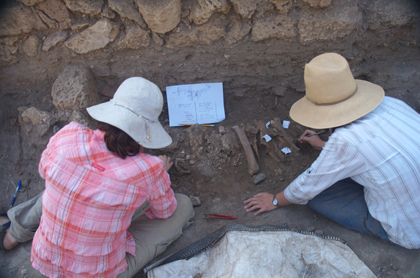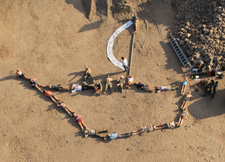Archaeozoology
 Archaeozoology is the identification, analysis and interpretation of animal remains from
archaeological sites. Dor is ideal for the diachronic study of the changes of
foodways and other uses of animal resources in an urban, Mediterranean maritime
environment, and comparison with other economies.
Archaeozoology is the identification, analysis and interpretation of animal remains from
archaeological sites. Dor is ideal for the diachronic study of the changes of
foodways and other uses of animal resources in an urban, Mediterranean maritime
environment, and comparison with other economies.
The appearance of domestic animals and their changing numbers in various periods offer information on the shifts in diet and other forms of animal exploitation.
Sheep and goat were the most common sources of meat, but there is some evidence for animals grown mainly for milk and wool, especially in later periods. Similarly, some of the cattle bones show minor deformations attributable to their use in tillage and transport, beyond their main use for beef. Remains of domestic pigs, dogs, camels, horses and donkeys are also found.
 Wild species are relatively rare at Dor - hunting was not a major food source.
However, large quantities of fish bones were recovered. A detailed study of these
may yield insights into ancient fishing techniques, methods of curing and conserving
fish (there is possible evidence for long-distance trade in Nile perch, for instance),
and changes in the Mediterranean ecosystem.
Wild species are relatively rare at Dor - hunting was not a major food source.
However, large quantities of fish bones were recovered. A detailed study of these
may yield insights into ancient fishing techniques, methods of curing and conserving
fish (there is possible evidence for long-distance trade in Nile perch, for instance),
and changes in the Mediterranean ecosystem.
One form of secondary exploitation is the manufacture of bone tools. Some of these are utilitarian and others ornamental - incised scapulae, ornamental pins, connecting rings, needles, spatulas, etc. Luxury items, however, were carved from hippo ivory. Shifts in manufacture techniques can be traced from the Bronze Age into Roman times.
Finally, Archaeozoology is a tool for reconstructing ecological change. The ancient environment around Dor was apparently much marshier than it is today. There is evidence that hippos, wild boars, giant sea-turtle, crocodiles, and perhaps even huge Nile perch existed in the swampy marshes around Dor until at least till the Iron Age.
